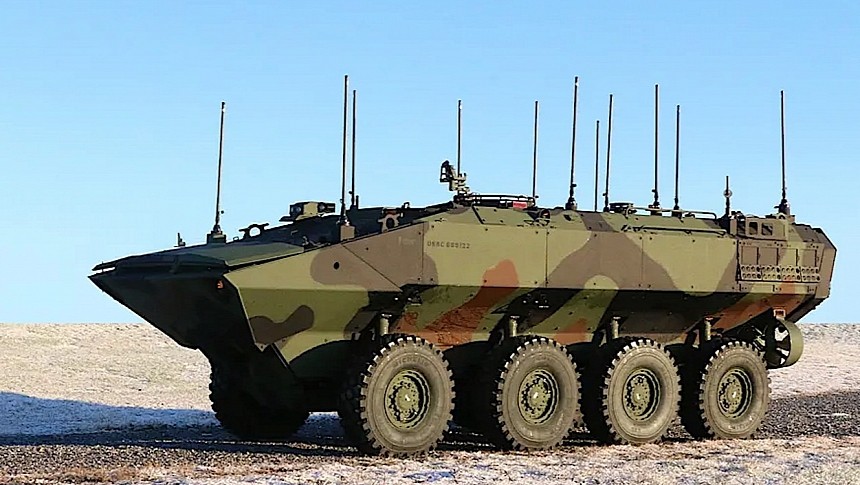The world we live in today is such that there is little need for amphibious assaults on enemy beaches at the moment. That could change, though, given events taking place in Europe, the Middle East, and Asia, and it's best for the world's militaries to be ready.
Because of the lack of an actual and immediate need for them, amphibious vehicles are not produced in large numbers anywhere in the world. In fact, there is a single kind rolling off the assembly lines as part of a full-rate production contract: the Amphibious Combat Vehicle (ACV) made by defense contractor BAE Systems.
The vehicle is the product of a contract the company received from the U.S. Marine Corps in late 2020. It will eventually comprise four variants, each of them with its own specific capability, namely the ACV-P, ACV-C, ACV-30, and ACV-R.
Of them only one was until earlier this week in operation, the ACV-P, which is basically the Personnel variant of the amphibious machine. This one can carry 13 combat-loaded Marines and three crew.
Earlier this week BAE Systems announced the first vehicle in the ACV-C configuration was delivered to the Marine Corps. It's the one meant for Command and Control duties, and even if its exact specs were not detailed, it comes across as a very capable nerve center for military operations.
The platform it is based on can travel for a total of 325 miles (523 km at speeds of 65 mph (105 kph). That's over land, because in the water the speed drops drastically, to just seven mph (11 kph) – but hey, it can move in the water as well, which is something few other vehicles today can do.
The 35-ton vehicle meant for Command and Control is kind of modular, and can be upgraded with new technologies as soon as they emerge or become relevant for military missions. That includes, for instance, the ACV-C's capability to become part of a Manned-Unmanned Teaming (MUM-T) system.
The remaining two versions of the amphibious fighter are presently in a Production Representative Test Vehicles (PRTV) stage. They should be delivered in this form to the Marine Corps for testing next year.
The ACV-30 is the weaponized version, and it comes equipped with a 30 mm Remote Turret System, while the ACV-R will be the first responder of the family, acting as direct field support, maintenance, and recovery of other amphibious vehicles.
The U.S. Marine Corps will not be the only military branch to use these vehicles. BAE Systems presented a version of it during a specialized event in Europe last year. The first nation to express interest in them was Spain, which plans to purchase ACVs for its Infanteria de Marina Espanola, the local equivalent of the Marine Corps.
The vehicle is the product of a contract the company received from the U.S. Marine Corps in late 2020. It will eventually comprise four variants, each of them with its own specific capability, namely the ACV-P, ACV-C, ACV-30, and ACV-R.
Of them only one was until earlier this week in operation, the ACV-P, which is basically the Personnel variant of the amphibious machine. This one can carry 13 combat-loaded Marines and three crew.
Earlier this week BAE Systems announced the first vehicle in the ACV-C configuration was delivered to the Marine Corps. It's the one meant for Command and Control duties, and even if its exact specs were not detailed, it comes across as a very capable nerve center for military operations.
The platform it is based on can travel for a total of 325 miles (523 km at speeds of 65 mph (105 kph). That's over land, because in the water the speed drops drastically, to just seven mph (11 kph) – but hey, it can move in the water as well, which is something few other vehicles today can do.
The 35-ton vehicle meant for Command and Control is kind of modular, and can be upgraded with new technologies as soon as they emerge or become relevant for military missions. That includes, for instance, the ACV-C's capability to become part of a Manned-Unmanned Teaming (MUM-T) system.
The remaining two versions of the amphibious fighter are presently in a Production Representative Test Vehicles (PRTV) stage. They should be delivered in this form to the Marine Corps for testing next year.
The ACV-30 is the weaponized version, and it comes equipped with a 30 mm Remote Turret System, while the ACV-R will be the first responder of the family, acting as direct field support, maintenance, and recovery of other amphibious vehicles.
The U.S. Marine Corps will not be the only military branch to use these vehicles. BAE Systems presented a version of it during a specialized event in Europe last year. The first nation to express interest in them was Spain, which plans to purchase ACVs for its Infanteria de Marina Espanola, the local equivalent of the Marine Corps.








